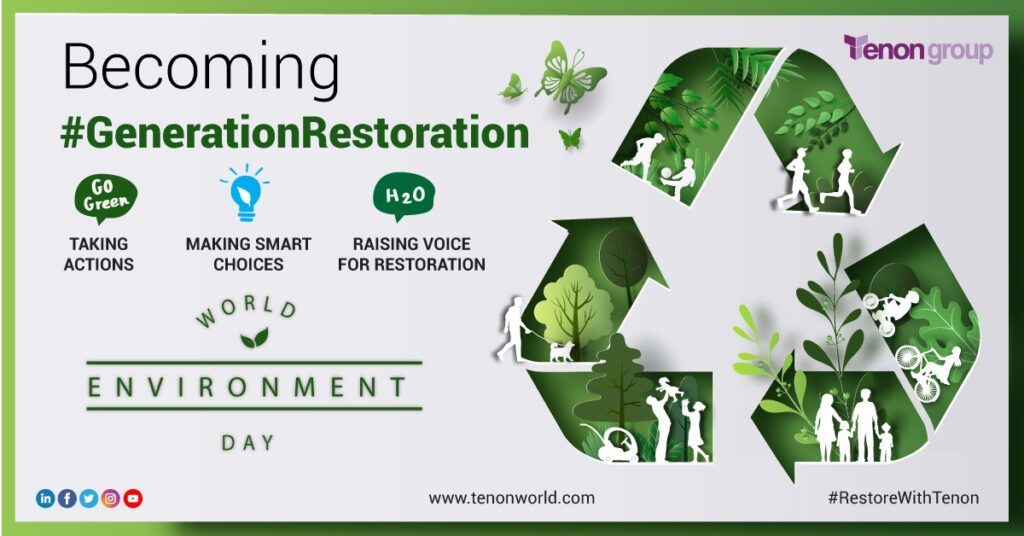The key priorities of sustainable development are intertwined with business activities. They are as much part of the solution as they are of the problem.
Every year, we lose ecosystem services worth more than 10 percent of our global economic output, says the latest synthesis report from the United Nations Environment Programme (UNEP). The COVID-19 pandemic has disrupted the world upside down, yet there are a few positive disruptions that have reset the priorities across the industries. One of these new priorities is the heightened focus on sustainability at workplaces.
The launch of UN Decade on Restoration has further jolted the real-estate players and facility managers into relooking and restrategizing their sustainable measures for environmental restoration. The global rallying cry to heal our planet is getting stronger and the time for building and maintaining sustainable facilities is now.
Building sustainable facilities:
A sustainable or green building refers to a building, in its design, construction, and operations, reduces its negative impact on the environment and can maintain and improve the quality of life of occupants. Any building, whether it is an office, home, school, or a hospital, can be transformed into a green building, provided it fulfills the following requirements:
- Efficiently uses energy, water, and other resources
- Opts for renewable energy such as solar energy, whereas possible
- Implements pollution and waste reduction measures, including re-use and recycling
- Maintains good indoor environmental air quality
- Uses non-toxic, ethical, and sustainable materials
- Considers the impact of its design, construction, and operations on the environment
- Prioritizes the quality of life of building occupants
Transforming old into smart and green:
Till 2020, India had over 7.55 billion sq. ft. of green built-up space and continues to expand in this segment, as per The Hindu Business Line. It means that we have completed 75% of IGBC’s goal of facilitating 10 billion sq ft of green building footprint by 2022. But, there’s still a long way to go. The greatest challenge is how to upgrade facilities with minimal environmental impact while also meeting ever-changing operational demands. Buildings use a variety of resources such as energy, water, and materials, etc., and also generate waste and release atmospheric emissions.
Facilities managers can enable the business owners to achieve sustainability, make buildings safe and healthy for occupants, and improving building resiliency at the same time with a 4-point action plan.
- Increase landfill diversion rate:
Increase the landfill diversion rate by introducing effective recycling programs at workplaces. The common goal of businesses should be to reduce, reuse, recover and recycle commercial waste by using suitable measures & technology.
> Set up a green team
Recruit team members from different departments to successfully implement and systematically run a recycling program.
> Conduct waste audit
Conduct a methodical waste audit to understand your organisation’s waste habits, streams, areas of improvement and set clear goals for the year.
> Compost organic waste
Collect all the organic waste produced in your organisation and compost it to produce soil fertilizers that enhance soil quality and reduce soil erosion.
>Implement an effective paper conscious policy
Commit to reducing paper usage in the office with a paper-conscious policy. Identify the processes that require paper and those that can easily be managed through technology.
>Focus on expanding recycling IQ
Raise awareness of reusing and recycling waste materials amongst your employees. Involve them in all recycling programs so that they understand their responsibilities.
>Stategize E-waste management
Partner with authorised E-waste recycling company that can collect E-waste from your sites and recycle or dispose of them as per the government laws
- Opt for Sustainable Landscaping:
Sustainable landscaping is the practice of opting for environment-friendly landscaping strategies aimed at preserving limited resources, reducing waste, and preventing air, water, and soil pollution. Here are the best practices for sustainable landscaping:
>Xeriscaping: Design landscapes using water-wise garden techniques and grow drought-tolerant plants that require less irrigation
>Carbon Sequestration: Use carbon sequestration methods to pull the heat-trapping gas, Co2 from the atmosphere and store it into the soil
>Grasscycling: Recycle & leave grass clippings on the lawn while mowing to decompose quickly providing rich nutrients to the soil
>Landscaping Equipment: Replace Gasoline-powered lawn and garden equipment (GLGE) with battery-powered tools to prevent localized emissions including air pollutants, criteria pollutants, and carbon dioxide (CO2)
- Optimize Water Efficiency:
Commercial facilities should take appropriate water efficiency measures such as water-saving technology to reduce the amount of potable water consumed in buildings.
>Make a commitment: Make water efficiency a vital part of your corporate sustainability
>Assess facility water use: Track your facility’s total water use with submeters
>Set and communicating goals: Set achievable water reduction goals for each financial year and encourage employees’ water-saving behaviour
>Create an action plan: Develop a clear and comprehensive action plan that illustrates how your facility uses water from entry to exit
>Implement the action plan: Begin with involving everyone in the new operational procedures so that all understand the purpose behind the plan
>Evaluate progress: Monitor the progress quarterly using leak detection and submetering
>Recognize achievement: Reward the key achievers for their water conservation efforts to set an example for others
- Build Energy Benchmarking:
Energy benchmarking helps to determine whether a building is using more or less energy than its peer facilities with similar occupancies and size.
>Evaluate performance: Monitor & track energy use in your building
>Identify improvement areas: Identify factors that affect energy efficiency
>Set goals: Use data & insights to set energy goals
>Plan of action: Develop a feasible energy-efficient plan. Put best practices into practice
>Evaluate: Analyze the impact & results
>Document improvements: Gather data points for further improvement
Final Thoughts:
The aforementioned concepts are not newer either for businesses or for facility managers. These are frequently talked about when it comes to facilities or building management yet these have also been overlooked. To become a part of the #GenerationRestoration movement, we must adopt such underestimated sustainable measures and reduce our impact on the environment and nature.




